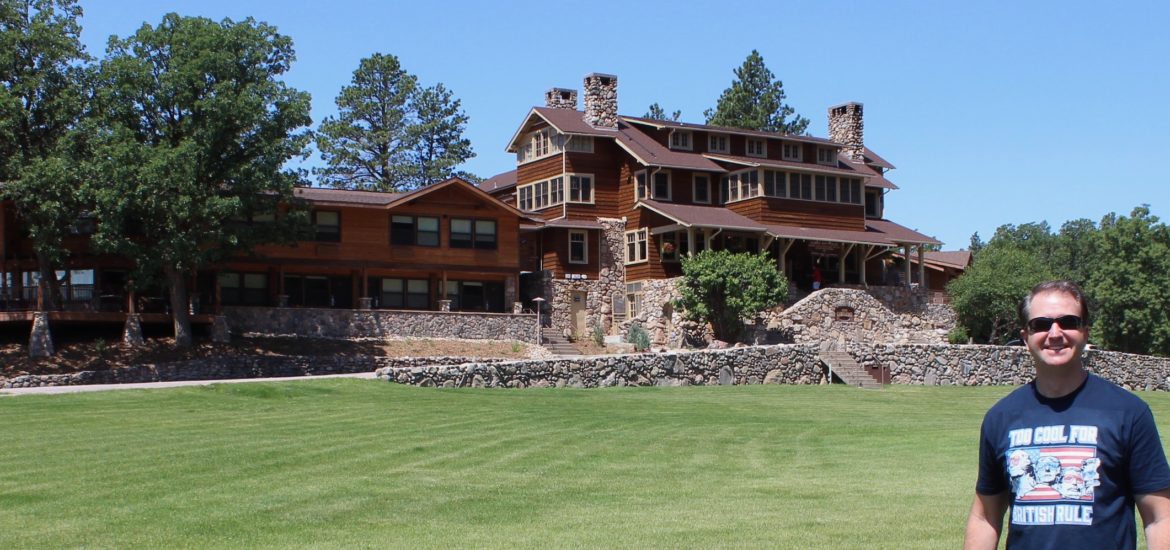It was July 4th and we awoke in Keystone, South Dakota. After the crazy thunderstorm the night before, the blue skies opened up and temperatures had cooled off slightly. We drove just a few minutes down the road from the Holy Smoke Resort to “downtown” Keystone and found a traditional American diner breakfast at Peggy’s Place. It was delicious and just what the doctor ordered.
 From there, we took a 30-minute drive south to Custer State Park. There is a ton to do here, but we really just came to see the historic State Game Lodge, that was considered the “Summer White House,” for one of our favorite U.S. Presidents, Calvin Coolidge. He made many summer visits here and one of them was for the dedication of the beginning of construction of Mount Rushmore in 1927. What’s funny is that Marshall and I and a couple other friends were in Key West earlier this year and visited the “Winter White House” of Harry Truman. At least we were keeping with the seasons appropriately, and making a bipartisan effort.
From there, we took a 30-minute drive south to Custer State Park. There is a ton to do here, but we really just came to see the historic State Game Lodge, that was considered the “Summer White House,” for one of our favorite U.S. Presidents, Calvin Coolidge. He made many summer visits here and one of them was for the dedication of the beginning of construction of Mount Rushmore in 1927. What’s funny is that Marshall and I and a couple other friends were in Key West earlier this year and visited the “Winter White House” of Harry Truman. At least we were keeping with the seasons appropriately, and making a bipartisan effort.
The good news about visiting here is the Lodge is not far from the park entrance. The bad news was that it cost us $20 to enter the park, where we were not going to be spending very much time. But since we had driven all this way, we went ahead and forked up the cost of admission. While the State Game Lodge was just a few miles into this massive state park, we saw a bison on the way in, and a deer on the way out. They were just finding some food along the roadside when we passed them.
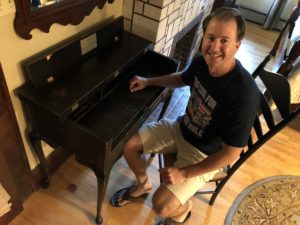 Once at the State Game Lodge, we first just browsed around for a few minutes on our own, and then asked the staff in the lobby about Calvin Coolidge’s stay here. They allowed us to go up one floor to see the room he stayed in, which is clearly labeled. They allow people to stay here, but we lucked out and the room was available to just walk right into. We toured the room and took a photo at the desk he used to write his resignation letter to the American people, informing them he would not seek re-election in 1928. Coolidge had first come into the Presidency after President Harding suffered an untimely death half way through his Presidency, succeeding him from the Vice President position. But after getting elected to the Presidency in 1924, “Cool Cal” decided that five and half years as President was long enough.
Once at the State Game Lodge, we first just browsed around for a few minutes on our own, and then asked the staff in the lobby about Calvin Coolidge’s stay here. They allowed us to go up one floor to see the room he stayed in, which is clearly labeled. They allow people to stay here, but we lucked out and the room was available to just walk right into. We toured the room and took a photo at the desk he used to write his resignation letter to the American people, informing them he would not seek re-election in 1928. Coolidge had first come into the Presidency after President Harding suffered an untimely death half way through his Presidency, succeeding him from the Vice President position. But after getting elected to the Presidency in 1924, “Cool Cal” decided that five and half years as President was long enough.
During our 30-minute drive from Keystone to President Coolidge’s “Summer White House,” I asked Marshall to pull up the speech that “Cool Cal” gave on the 150th Anniversary of the Declaration of Independence. After all, today was yet another anniversary of that historic speech.
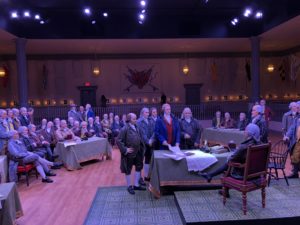 As we approached Coolidge’s “Summer White House,” Marshall read out loud some of the most important lines of the speech as we approached:
As we approached Coolidge’s “Summer White House,” Marshall read out loud some of the most important lines of the speech as we approached:
About the Declaration there is a finality that is exceedingly restful. It is often asserted that the world has made a great deal of progress since 1776, that we have had new thoughts and new experiences which have given us a great advance over the people of that day, and that we may therefore very well discard their conclusions for something more modern. But that reasoning can not be applied to this great charter. If all men are created equal, that is final. If they are endowed with inalienable rights, that is final. If governments derive their just powers from the consent of the governed, that is final. No advance, no progress can be made beyond these propositions. If anyone wishes to deny their truth or their soundness, the only direction in which he can proceed historically is not forward, but backward toward the time when there was no equality, no rights of the individual, no rule of the people. Those who wish to proceed in that direction can not lay claim to progress. They are reactionary. Their ideas are not more modern, but more ancient, than those of the Revolutionary fathers.
Profound words about a profound document.
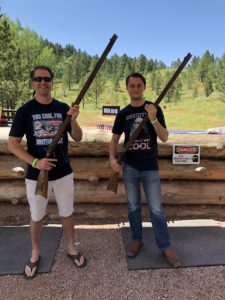 After our brief visit here, we left Custer State Park and headed up to Rapid City, where we continued to commemorate this Independence Day with a stop at America’s Founding Fathers Exhibit. It looks like one of those hokey tourist trap type places, but a friend had recommended we come here. And it was an excellent idea, especially on this special day for our country.
After our brief visit here, we left Custer State Park and headed up to Rapid City, where we continued to commemorate this Independence Day with a stop at America’s Founding Fathers Exhibit. It looks like one of those hokey tourist trap type places, but a friend had recommended we come here. And it was an excellent idea, especially on this special day for our country.
The main attraction here is an exhibit that pays tribute to John Trumbull’s famous painting of the signing of the Declaration of Independence. Except, instead of a painting, it was a full scale model of all the men in the same place they are in that painting. It feels like you just stepped into the room that the painting depicts. A member of the museum staff gives an introduction and then a presentation goes forward telling you about many of the men there. The museum staffer made the point that there were 56 men who signed the Declaration, but we probably can’t name more than a handful. Yet all those men sacrificed so much and without any single one of them, this independence movement from England likely wouldn’t have happened. Most were not there to see the Constitution. Many were not there even to see the end of the War for Independence. They would not see the fruits of the actions they took. And none could probably ever have imagined what would become of this young nation.
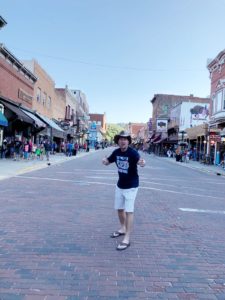 After the presentation was over, we were able to walk around and read about each of the men, with their individual pictures on the wall along with a little biography about them. I felt grateful for what they did for us. And as Calvin Coolidge reminded our nation 150 years after the Declaration was signed, what these men accomplished for humanity was just astounding.
After the presentation was over, we were able to walk around and read about each of the men, with their individual pictures on the wall along with a little biography about them. I felt grateful for what they did for us. And as Calvin Coolidge reminded our nation 150 years after the Declaration was signed, what these men accomplished for humanity was just astounding.
The other cool part of this experience is that you can pay a little extra to go outside and out back and shoot an authentic Revolutionary Era flintlock rifle, with our targets being a British redcoat. We were able to fire three shots each, with the help of an instructor who loaded the real live firearms for us. They take a while to load and reload. There’s also a Liberty Bell outside in front of the exhibit that you can ring. And you know we did.
Our day then continued. We got some lunch on the way out of Rapid City and drove about 45 minutes north to Deadwood. We sort of flashed forward a hundred years into history as this is a famous western town that was populated during the time of the American Gold Rush. Outlaws such as “Wild Bill” Hickock lived here. We went and grabbed a drink at the saloon where he was shot and killed at on August 2, 1876. At least he got to live to see the 100th anniversary of the Declaration of Independence. We also found a great cigar bar and enjoyed a taste of freedom on this historic day.
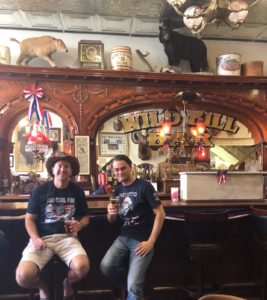 Deadwood is a real authentic western town, there is even a HBO show that, while not filmed here, is set here in the late 1800s. The only unfortunate thing about Deadwood today is that nearly all the buildings are either casinos, bars, or souvenir tourist shops. So, if you’re into any of that, I’m sure you’ll enjoy it. We missed the Fourth of July parade (I read something wrong and we were off by about an hour). But we had fun here nonetheless.
Deadwood is a real authentic western town, there is even a HBO show that, while not filmed here, is set here in the late 1800s. The only unfortunate thing about Deadwood today is that nearly all the buildings are either casinos, bars, or souvenir tourist shops. So, if you’re into any of that, I’m sure you’ll enjoy it. We missed the Fourth of July parade (I read something wrong and we were off by about an hour). But we had fun here nonetheless.
As evening rolled on, we drove over to nearby Lead, where we planned to watch the fireworks over the “Open Cut,” where there was once a gold mine. The only problem was, we were getting hungry. There weren’t many good options in Deadwood and nothing much on the way. But as we pulled into Lead, which seemed like a quiet small town, we found a place with a sign outside that said there were bbq, burgers, hot dogs, beer, and live music. We decided to give it a try. It was called the High Country Grub N Waterin’ Hole.
As soon as we walked in, we met Tom who had a bunch of fixings all laid out on a table. We each had a burger with a few sides, with a beer. He charged us like $6 each. I was amazed. He then sat down with us and we exchanged stories. He is a veteran, probably in his late 40s or so. He and his girlfriend live here, where she is from. I believe he said he was from another part of South Dakota, but I forget. He just opened this business the previous weekend. He must have known we were coming.
 Tom said there aren’t many simple food options like this around town and he asked the local people what they wanted and they said something like this, so that’s why he created it. He also said he specifically created it for locals, not tourists like us, but we were an added bonus to his business plan today. But it didn’t feel like a business, it felt like we walked into his home, as he continued spending time getting to know us.
Tom said there aren’t many simple food options like this around town and he asked the local people what they wanted and they said something like this, so that’s why he created it. He also said he specifically created it for locals, not tourists like us, but we were an added bonus to his business plan today. But it didn’t feel like a business, it felt like we walked into his home, as he continued spending time getting to know us.
The band started playing some music to the dozen or so people there at the time. Everyone seemed to know each other and were super friendly. Marshall and I finished dinner, left our car parked in front of Tom’s restaurant, and took a 10-minute walk to “downtown” Lead where there were hundreds, maybe even a thousand or so people all gathered around the “Open Cut,” having a good time and preparing to watch the fireworks once the sun went down.
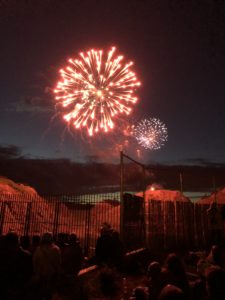 We started a few conversations with people, mostly asking them about the fireworks here and what to expect, and the best places to view them from. Everyone here was super friendly. They also seemed to love meeting people from Florida. “You’re a long way from home,” was a line we heard quite a few times. We didn’t meet many people from Florida anywhere in South Dakota. It is a long way. But, every once in a while, someone would tell us they just met someone else from Florida.
We started a few conversations with people, mostly asking them about the fireworks here and what to expect, and the best places to view them from. Everyone here was super friendly. They also seemed to love meeting people from Florida. “You’re a long way from home,” was a line we heard quite a few times. We didn’t meet many people from Florida anywhere in South Dakota. It is a long way. But, every once in a while, someone would tell us they just met someone else from Florida.
The fireworks were spectacular, and they lasted about 15 minutes or so. We then walked back up to the restaurant, used the facilities, said goodbye to Tom and company, and drove about an hour back to Keystone and off to sleep. During our drive, Marshall and I talked about how much we really enjoyed this state and the people in it. They were so friendly and hard-working, and they loved their country. It’s always amazing to me how large and expansive this country is. We live thousands of miles away from South Dakota, and yet, we are all Americans, celebrating the same heritage. We are a people of many ethnicities and backgrounds, but our common heritage is the Declaration of Independence and all it stands for. And on this anniversary of the signing of that great document, that was enough of a reason to be grateful and sleep well peacefully in the quiet surroundings of the Black Hills of South Dakota.
***
 The next morning, we drove back to Denver, with much of our drive going through a good chunk of Wyoming. We stopped in Cheyenne, the state capital, where the capitol building was under renovation. We ate lunch at Sanford’s, a great restaurant with lots of cool memorabilia. Marshall pointed out a statue of Elvis Presley to me. “There’s your boy,” he said. I said hello to Elvis and snagged a photo with him. I’m sure the King would have loved this place. We filled up on some grub, and watched a few minutes of Wimbledon which was playing on many of the television screens around this sports pub looking place. We then got back in the car for the final stretch to Denver, before we each departed back to Florida.
The next morning, we drove back to Denver, with much of our drive going through a good chunk of Wyoming. We stopped in Cheyenne, the state capital, where the capitol building was under renovation. We ate lunch at Sanford’s, a great restaurant with lots of cool memorabilia. Marshall pointed out a statue of Elvis Presley to me. “There’s your boy,” he said. I said hello to Elvis and snagged a photo with him. I’m sure the King would have loved this place. We filled up on some grub, and watched a few minutes of Wimbledon which was playing on many of the television screens around this sports pub looking place. We then got back in the car for the final stretch to Denver, before we each departed back to Florida.
